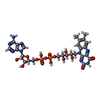+ Open data
Open data
- Basic information
Basic information
| Entry | Database: PDB / ID: 4zvk | ||||||
|---|---|---|---|---|---|---|---|
| Title | Reduced quinone reductase 2 in complex with ethidium | ||||||
 Components Components | Ribosyldihydronicotinamide dehydrogenase [quinone] | ||||||
 Keywords Keywords | Oxidoreductase/oxidoreductase Inhibitor / quinone reductase 2 / ethidium bromide / Oxidoreductase-Inhibitor complex / Oxidoreductase-oxidoreductase Inhibitor complex | ||||||
| Function / homology |  Function and homology information Function and homology informationribosyldihydronicotinamide dehydrogenase (quinone) / dihydronicotinamide riboside quinone reductase activity / quinone catabolic process / resveratrol binding / oxidoreductase activity, acting on other nitrogenous compounds as donors / melatonin binding / NAD(P)H dehydrogenase (quinone) activity / Phase I - Functionalization of compounds / chloride ion binding / FAD binding ...ribosyldihydronicotinamide dehydrogenase (quinone) / dihydronicotinamide riboside quinone reductase activity / quinone catabolic process / resveratrol binding / oxidoreductase activity, acting on other nitrogenous compounds as donors / melatonin binding / NAD(P)H dehydrogenase (quinone) activity / Phase I - Functionalization of compounds / chloride ion binding / FAD binding / electron transfer activity / oxidoreductase activity / protein homodimerization activity / extracellular exosome / zinc ion binding / nucleoplasm / cytosol Similarity search - Function | ||||||
| Biological species |  Homo sapiens (human) Homo sapiens (human) | ||||||
| Method |  X-RAY DIFFRACTION / X-RAY DIFFRACTION /  MOLECULAR REPLACEMENT / MOLECULAR REPLACEMENT /  molecular replacement / Resolution: 1.867 Å molecular replacement / Resolution: 1.867 Å | ||||||
| Model details | Metallo-flavoprotein | ||||||
 Authors Authors | Leung, K.K. / Shilton, B.H. | ||||||
 Citation Citation |  Journal: Biochemistry / Year: 2015 Journal: Biochemistry / Year: 2015Title: Binding of DNA-Intercalating Agents to Oxidized and Reduced Quinone Reductase 2. Authors: Leung, K.K. / Shilton, B.H. | ||||||
| History |
|
- Structure visualization
Structure visualization
| Structure viewer | Molecule:  Molmil Molmil Jmol/JSmol Jmol/JSmol |
|---|
- Downloads & links
Downloads & links
- Download
Download
| PDBx/mmCIF format |  4zvk.cif.gz 4zvk.cif.gz | 194.7 KB | Display |  PDBx/mmCIF format PDBx/mmCIF format |
|---|---|---|---|---|
| PDB format |  pdb4zvk.ent.gz pdb4zvk.ent.gz | 155.1 KB | Display |  PDB format PDB format |
| PDBx/mmJSON format |  4zvk.json.gz 4zvk.json.gz | Tree view |  PDBx/mmJSON format PDBx/mmJSON format | |
| Others |  Other downloads Other downloads |
-Validation report
| Summary document |  4zvk_validation.pdf.gz 4zvk_validation.pdf.gz | 1.7 MB | Display |  wwPDB validaton report wwPDB validaton report |
|---|---|---|---|---|
| Full document |  4zvk_full_validation.pdf.gz 4zvk_full_validation.pdf.gz | 1.7 MB | Display | |
| Data in XML |  4zvk_validation.xml.gz 4zvk_validation.xml.gz | 21.7 KB | Display | |
| Data in CIF |  4zvk_validation.cif.gz 4zvk_validation.cif.gz | 31.4 KB | Display | |
| Arichive directory |  https://data.pdbj.org/pub/pdb/validation_reports/zv/4zvk https://data.pdbj.org/pub/pdb/validation_reports/zv/4zvk ftp://data.pdbj.org/pub/pdb/validation_reports/zv/4zvk ftp://data.pdbj.org/pub/pdb/validation_reports/zv/4zvk | HTTPS FTP |
-Related structure data
| Related structure data | 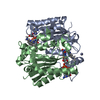 4zvlC  4zvmC  4zvnC 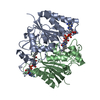 1qr2S C: citing same article ( S: Starting model for refinement |
|---|---|
| Similar structure data |
- Links
Links
- Assembly
Assembly
| Deposited unit | 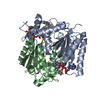
| ||||||||
|---|---|---|---|---|---|---|---|---|---|
| 1 |
| ||||||||
| Unit cell |
|
- Components
Components
| #1: Protein | Mass: 25849.338 Da / Num. of mol.: 2 Source method: isolated from a genetically manipulated source Source: (gene. exp.)  Homo sapiens (human) / Gene: NQO2, NMOR2 / Plasmid: pProEXhta / Production host: Homo sapiens (human) / Gene: NQO2, NMOR2 / Plasmid: pProEXhta / Production host:  #2: Chemical | #3: Chemical | #4: Chemical | #5: Water | ChemComp-HOH / | Sequence details | The mismatch between F46 (in the deposited structure) and L47 (from UNP P16083) is due to SNP ...The mismatch between F46 (in the deposited structure) and L47 (from UNP P16083) is due to SNP rs1143684. Both forms of NQO2 are found in the population where F46 is the predominant form in the population. For your reference - 1. Megarity, C. F., Gill, J. R. E., Caraher, M. C., Stratford, I. J., Nolan, K. a, and Timson, D. J. (2014) The two common polymorphic forms of human NRH-quinone oxidoreductase 2 (NQO2) have different biochemical properties. FEBS Lett. 588, 1666-72 | |
|---|
-Experimental details
-Experiment
| Experiment | Method:  X-RAY DIFFRACTION / Number of used crystals: 1 X-RAY DIFFRACTION / Number of used crystals: 1 |
|---|
- Sample preparation
Sample preparation
| Crystal | Density Matthews: 2.42 Å3/Da / Density % sol: 49.15 % / Description: Yellow rods |
|---|---|
| Crystal grow | Temperature: 298 K / Method: vapor diffusion, sitting drop / pH: 7 / Details: 1.7M Ammonium sulfate, 0.1M Hepes |
-Data collection
| Diffraction | Mean temperature: 100 K | |||||||||||||||||||||||||||
|---|---|---|---|---|---|---|---|---|---|---|---|---|---|---|---|---|---|---|---|---|---|---|---|---|---|---|---|---|
| Diffraction source | Source:  ROTATING ANODE / Type: RIGAKU RUH2R / Wavelength: 1.54 Å ROTATING ANODE / Type: RIGAKU RUH2R / Wavelength: 1.54 Å | |||||||||||||||||||||||||||
| Detector | Type: MAR scanner 345 mm plate / Detector: IMAGE PLATE / Date: Sep 21, 2014 | |||||||||||||||||||||||||||
| Radiation | Monochromator: Osmic Confocol Max-Flux (CMF) graphite monochromator Protocol: SINGLE WAVELENGTH / Monochromatic (M) / Laue (L): M / Scattering type: x-ray | |||||||||||||||||||||||||||
| Radiation wavelength | Wavelength: 1.54 Å / Relative weight: 1 | |||||||||||||||||||||||||||
| Reflection | Resolution: 1.86→16.27 Å / Num. obs: 39460 / % possible obs: 92.2 % / Redundancy: 4.4 % / Biso Wilson estimate: 17.87 Å2 / CC1/2: 0.995 / Rmerge(I) obs: 0.123 / Rpim(I) all: 0.063 / Net I/σ(I): 9.4 / Num. measured all: 174456 / Scaling rejects: 12 | |||||||||||||||||||||||||||
| Reflection shell | Diffraction-ID: 1 / Rejects: _
|
-Phasing
| Phasing | Method:  molecular replacement molecular replacement |
|---|
- Processing
Processing
| Software |
| |||||||||||||||||||||||||||||||||||||||||||||||||||||||||||||||||||||||||||||||||||||||||||||||||||||||||
|---|---|---|---|---|---|---|---|---|---|---|---|---|---|---|---|---|---|---|---|---|---|---|---|---|---|---|---|---|---|---|---|---|---|---|---|---|---|---|---|---|---|---|---|---|---|---|---|---|---|---|---|---|---|---|---|---|---|---|---|---|---|---|---|---|---|---|---|---|---|---|---|---|---|---|---|---|---|---|---|---|---|---|---|---|---|---|---|---|---|---|---|---|---|---|---|---|---|---|---|---|---|---|---|---|---|---|
| Refinement | Method to determine structure:  MOLECULAR REPLACEMENT MOLECULAR REPLACEMENTStarting model: 1QR2 Resolution: 1.867→16.27 Å / SU ML: 0.2 / Cross valid method: FREE R-VALUE / σ(F): 1.34 / Phase error: 18.51 / Stereochemistry target values: ML
| |||||||||||||||||||||||||||||||||||||||||||||||||||||||||||||||||||||||||||||||||||||||||||||||||||||||||
| Solvent computation | Shrinkage radii: 0.9 Å / VDW probe radii: 1.11 Å / Solvent model: FLAT BULK SOLVENT MODEL | |||||||||||||||||||||||||||||||||||||||||||||||||||||||||||||||||||||||||||||||||||||||||||||||||||||||||
| Displacement parameters | Biso max: 104.28 Å2 / Biso mean: 22.2187 Å2 / Biso min: 5.12 Å2 | |||||||||||||||||||||||||||||||||||||||||||||||||||||||||||||||||||||||||||||||||||||||||||||||||||||||||
| Refinement step | Cycle: final / Resolution: 1.867→16.27 Å
| |||||||||||||||||||||||||||||||||||||||||||||||||||||||||||||||||||||||||||||||||||||||||||||||||||||||||
| Refine LS restraints |
| |||||||||||||||||||||||||||||||||||||||||||||||||||||||||||||||||||||||||||||||||||||||||||||||||||||||||
| LS refinement shell | Refine-ID: X-RAY DIFFRACTION / Total num. of bins used: 14
|
 Movie
Movie Controller
Controller




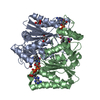
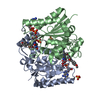


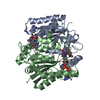

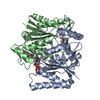

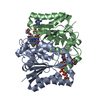
 PDBj
PDBj

